小学英语口语第二课_MJ
四年级英语书第二课

四年级英语书第二课Four-year-old English Book Lesson 2In today's lesson, we will embark on an adventure to explore the fascinating world of English greetings and introductions. Learning how to greet and introduce ourselves in English is an important skill that will not only enable us to communicate effectively but also empower us to build new relationships and connect with people from different cultures. So, let's dive right in!1. Greetings - Saying Hello------------In English, we have various ways to greet each other depending on the time of day and the level of formality. Here are some common greetings:- Good morning! (Used before noon)- Good afternoon! (Used after noon until evening)- Good evening! (Used from late afternoon/evening until bedtime)- Hello! (A general greeting used anytime)Remember to always greet others with a smile and a friendly tone. Greetings are essential to start conversations on a positive and polite note.2. Introducing Yourself------------Now that we know how to greet someone in English, let's move on to introducing ourselves. Here's a simple format to help you introduce yourself confidently:- Hi, my name is [Your Name].- I am [age] years old.- I live in [your city/country].- I like [hobbies or interests].For example, you can say, "Hi, my name is Emily. I am 9 years old. I live in Beijing, China. I like drawing and playing the piano."Remember to speak clearly and confidently when introducing yourself. Don't forget to smile and be attentive to the person you are talking to.3. Asking and Answering "How are you?"------------In English, it's common to ask people how they are as a way to show genuine interest in their well-being. Here's an example dialogue:Person A: "Hi, Emily! How are you?"Person B: "Hello, John! I'm good, thank you. How about you?"Person A: "I'm great, thanks for asking!"When answering the question, you can use various adjectives like "good," "great," "fine," or even "not so good" if you are having a bad day.Remember to always ask the other person how they are in return to show that you care about their well-being too.4. Expressing Politeness - "Please" and "Thank You"------------Politeness is highly valued in English-speaking countries, and using "please" and "thank you" is an important part of demonstrating good manners. Here are some examples of how to use them:- May I please borrow a pencil?- Could you please pass me the book?- Thank you for helping me.Using these phrases shows respect and gratitude towards others. Remember to use them whenever necessary, and you will create a positive impression when communicating in English.5. Farewells - Saying Goodbye------------Just as greetings are essential, knowing how to say goodbye is equally important. Here are some common ways to say goodbye:- Goodbye! (A general farewell)- See you later! (Used when you will see the person again soon)- Have a nice day! (Used to wish someone a pleasant day)Feel free to experiment with different farewells, but ensure they are appropriate for the situation and relationship with the person you are bidding farewell to.Conclusion------------Learning greetings and introductions is a fundamental step in mastering English communication skills. By understanding the different greetings, introducing ourselves confidently, asking and answering "How are you?," expressing politeness, and using appropriate farewells, we can successfully navigate social interactions and build connections with people from diverse backgrounds. Keep practicing these skills, and you will soon become a fluent English speaker!Remember, practice makes perfect!。
帮我默写六年级下册科普版英语第二课
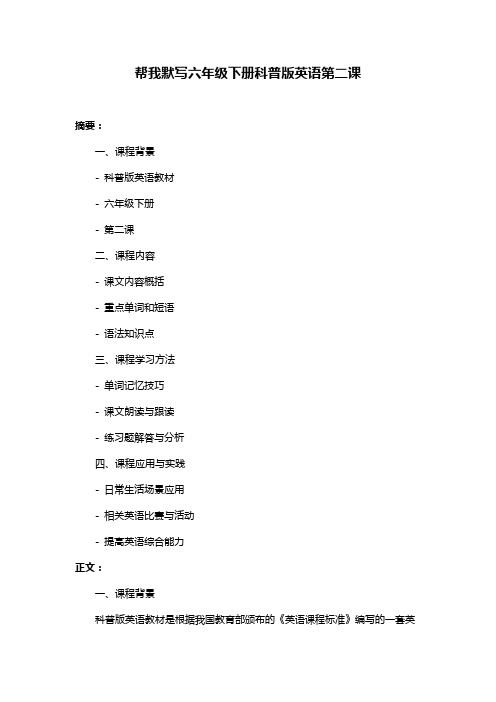
帮我默写六年级下册科普版英语第二课
摘要:
一、课程背景
- 科普版英语教材
- 六年级下册
- 第二课
二、课程内容
- 课文内容概括
- 重点单词和短语
- 语法知识点
三、课程学习方法
- 单词记忆技巧
- 课文朗读与跟读
- 练习题解答与分析
四、课程应用与实践
- 日常生活场景应用
- 相关英语比赛与活动
- 提高英语综合能力
正文:
一、课程背景
科普版英语教材是根据我国教育部颁布的《英语课程标准》编写的一套英
语教材,旨在帮助学生通过不同话题的学习,提高英语听说读写能力。
本篇内容为六年级下册的第二课,通过有趣的故事和实用的对话,让学生在轻松愉快的氛围中学习英语。
二、课程内容
第二课的课文内容围绕着一个科学实验展开,通过讲述实验过程和结果,引导学生学习英语。
课文中涉及的重点单词和短语有:experiment(实验)、result(结果)、observe(观察)等。
语法知识点包括一般现在时、一般过去时以及动词的一般现在时第三人称单数形式等。
三、课程学习方法
为了更好地学习第二课的内容,学生可以采用以下方法:首先,熟记课文中的重点单词和短语,可以通过制作单词卡片、编写顺口溜等方法进行记忆;其次,反复朗读和跟读课文,模仿课文的语音、语调,提高口语表达能力;最后,认真完成课后练习题,并参考答案进行自我检查和分析,及时发现并弥补自己的不足。
四、课程应用与实践
学习第二课后,学生可以将所学的知识应用到日常生活场景中,例如在科学课堂上讲述自己的实验过程,用英语描述实验结果;参加相关的英语比赛和活动,锻炼自己的英语实际运用能力。
五年级下英语第二课译林真人 讲解
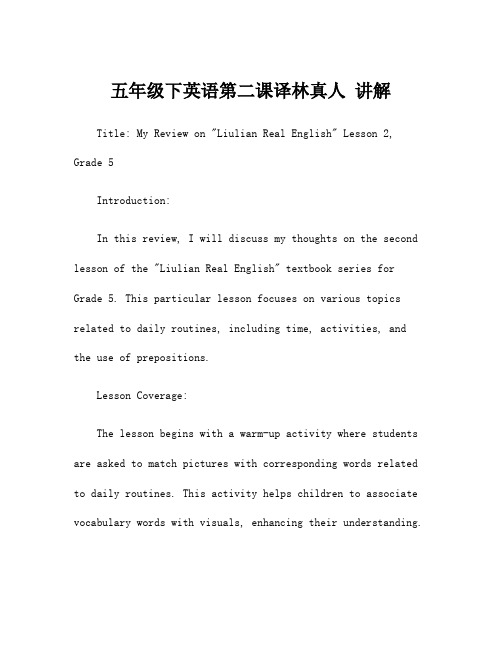
五年级下英语第二课译林真人讲解Title: My Review on "Liulian Real English" Lesson 2, Grade 5Introduction:In this review, I will discuss my thoughts on the second lesson of the "Liulian Real English" textbook series for Grade 5. This particular lesson focuses on various topics related to daily routines, including time, activities, and the use of prepositions.Lesson Coverage:The lesson begins with a warm-up activity where students are asked to match pictures with corresponding words related to daily routines. This activity helps children to associate vocabulary words with visuals, enhancing their understanding.Next, the teacher introduces new vocabulary words such as "get up," "brush teeth," "have breakfast," and "go to school." The use of real-life examples and context-rich sentences helps learners to comprehend the meaning and usage of these words in a practical manner.Grammar Points:One of the key grammar points covered in this lesson is the use of prepositions. Students are taught about different prepositions, such as "at," "on," and "in," and how they are used to express time, place, and manner. Engaging activities, including filling in the blanks using appropriate prepositions in sentences, provide practical applications of this grammar concept.Listening and Speaking Activities:To enhance students' listening skills and understanding of daily routines, the lesson includes several audio dialogues and exercises. By listening to the conversations,students learn how to ask and answer questions about daily activities. These activities encourage learners to actively participate in speaking and expressing their ideas in English.Reading and Writing Activities:The lesson incorporates reading comprehension exercises that require students to read short passages about daily routines and answer questions based on their understanding. This helps improve reading skills and comprehension abilities.In terms of writing, learners are guided to write about their own daily routines. They are encouraged to describetheir morning routines, including what time they wake up,what they do first, and how they prepare for the school day. This exercise enhances their writing skills and enables themto convey information effectively.Interactive Games and Digital Resources:In addition to the textbook content, the "Liulian Real English" series provides interactive games, songs, anddigital resources that supplement the lesson. These resources create an engaging learning environment and reinforce the taught concepts in an interactive manner.Conclusion:The second lesson of the "Liulian Real English" seriesfor Grade 5 effectively covers various aspects of daily routines, including vocabulary, grammar, listening, speaking, reading, and writing. The inclusion of interactive activities, real-life examples, and digital resources makes the learning experience enjoyable and effective for young learners. Byusing this textbook series, students can acquire English language skills while developing an interest in the language and culture.。
五年级下册英语第二课汉语
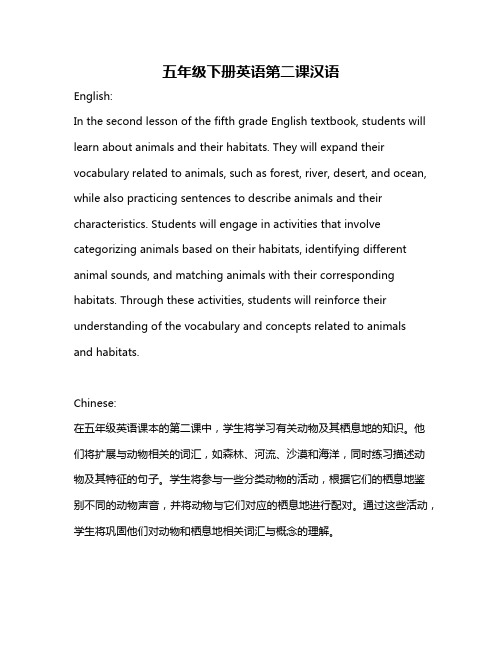
五年级下册英语第二课汉语English:In the second lesson of the fifth grade English textbook, students will learn about animals and their habitats. They will expand their vocabulary related to animals, such as forest, river, desert, and ocean, while also practicing sentences to describe animals and their characteristics. Students will engage in activities that involve categorizing animals based on their habitats, identifying different animal sounds, and matching animals with their corresponding habitats. Through these activities, students will reinforce their understanding of the vocabulary and concepts related to animalsand habitats.Chinese:在五年级英语课本的第二课中,学生将学习有关动物及其栖息地的知识。
他们将扩展与动物相关的词汇,如森林、河流、沙漠和海洋,同时练习描述动物及其特征的句子。
学生将参与一些分类动物的活动,根据它们的栖息地鉴别不同的动物声音,并将动物与它们对应的栖息地进行配对。
通过这些活动,学生将巩固他们对动物和栖息地相关词汇与概念的理解。
二年级外研版英语书上册第二课的对话怎么读
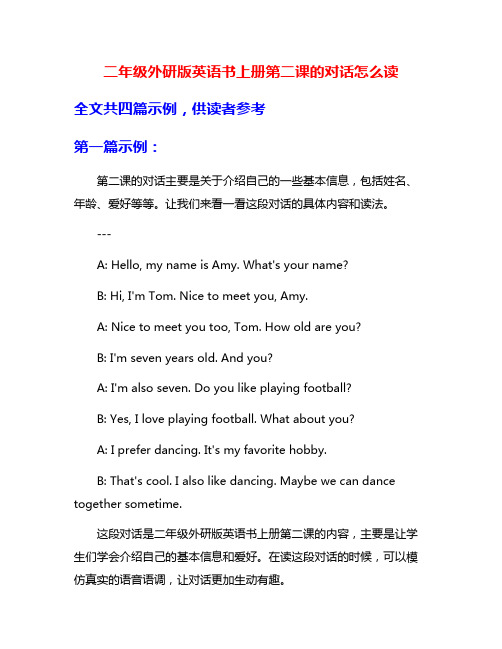
二年级外研版英语书上册第二课的对话怎么读全文共四篇示例,供读者参考第一篇示例:第二课的对话主要是关于介绍自己的一些基本信息,包括姓名、年龄、爱好等等。
让我们来看一看这段对话的具体内容和读法。
---A: Hello, my name is Amy. What's your name?B: Hi, I'm Tom. Nice to meet you, Amy.A: Nice to meet you too, Tom. How old are you?B: I'm seven years old. And you?A: I'm also seven. Do you like playing football?B: Yes, I love playing football. What about you?A: I prefer dancing. It's my favorite hobby.B: That's cool. I also like dancing. Maybe we can dance together sometime.这段对话是二年级外研版英语书上册第二课的内容,主要是让学生们学会介绍自己的基本信息和爱好。
在读这段对话的时候,可以模仿真实的语音语调,让对话更加生动有趣。
首先要注意语速和停顿的位置,在两个人对话的时候,要适当地停顿让对方有回答的时间,避免对话显得生硬。
在读对话的时候,要注意语气的变化,比如疑问句要带上上扬的语气,陈述句则要平稳自然。
除了语音语调,还要注意正确的发音和连读。
在读对话的时候,要注意每个单词的发音是否准确,特别是一些辅音和元音的发音要清晰。
要注意一些连读的情况,比如连读音变、连读音标等等,让对话流畅自然。
通过对这段对话的认真学习和模仿,可以帮助学生们提高口语表达能力,让他们在日常生活中更加自信地与他人交流。
希望同学们能够好好练习这段对话,让自己的英语口语越来越流利!第二篇示例:二年级外研版英语上册第二课是关于“Hello! What's your name?”的内容。
四年级英语第二课

四年级英语第二课英语课程在小学教育中占有重要地位。
通过学习英语,学生们能够培养语言能力,增加跨文化交流的机会,同时扩展他们的知识面。
在四年级英语课程中,第二课是一个重要的教学环节。
本文将介绍四年级英语第二课的内容和教学方法。
四年级英语第二课的主题是“我的家庭”。
通过这一课程,学生们将学习如何描述家庭成员以及他们的职业。
这个主题有助于学生们更好地了解家庭的重要性,并培养他们的社交能力。
以下是这节课的教学内容和方法。
一、教学内容在这节课上,学生们将学习以下内容:1. 学习家庭成员的称谓,如父亲、母亲、兄弟、姐妹等。
2. 学习如何用英语描述家庭成员的职业,如父亲是医生,母亲是教师等。
3. 学习如何用句子描述自己的家庭,如“My father is a doctor. My mother is a teacher. I have a brother and a sister.”二、教学方法为了有效地教授这节课,教师可以采用以下方法:1. 观看图片:教师可以准备一些家庭成员和职业的图片,并展示给学生们观看。
教师可以引导学生们观察图片,然后用英语描述图片中的人物以及他们的职业。
2. 角色扮演:教师可以组织学生们进行角色扮演。
学生们可以扮演自己的家庭成员,并用英语来介绍自己的家庭成员和他们的职业。
3. 听力练习:教师可以播放一段关于家庭成员和职业的录音,并让学生们听后回答问题。
这样可以帮助学生们提高听力理解能力。
4. 小组讨论:教师可以将学生分成小组,让他们一起讨论自己的家庭成员和他们的职业。
每个小组可以向全班展示他们的讨论结果,从而培养学生们的口头表达能力。
三、教学评估在这节课结束后,为了评估学生们的学习情况,可以采用以下方法:1. 口头测试:教师可以向学生们提问,要求他们用英语回答关于家庭成员和职业的问题。
2. 写作练习:教师可以让学生们写一篇短文来介绍自己的家庭成员和他们的职业。
以上是关于四年级英语第二课的内容和教学方法的简要介绍。
科普版三年级英语上册 Lesson 2 知识清单
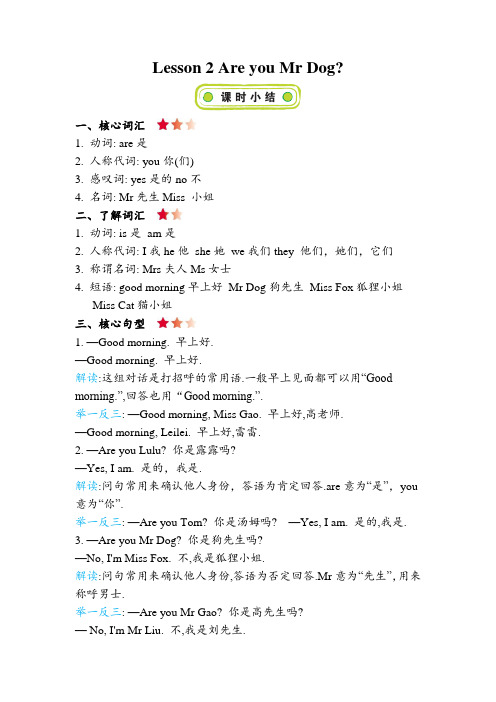
Lesson 2 Are you Mr Dog?
一、核心词汇
1. 动词: are是
2. 人称代词: you你(们)
3. 感叹词: yes是的no不
4. 名词: Mr先生Miss 小姐
二、了解词汇
1. 动词: is是am是
2. 人称代词: I我he他she她we我们they 他们,她们,它们
3. 称谓名词: Mrs夫人Ms女士
4. 短语: good morning早上好Mr Dog狗先生Miss Fox狐狸小姐
Miss Cat猫小姐
三、核心句型
1. —Good morning. 早上好.
—Good morning. 早上好.
解读:这组对话是打招呼的常用语.一般早上见面都可以用“Good morning.”,回答也用“Good morning.”.
举一反三: —Good morning, Miss Gao. 早上好,高老师.
—Good morning, Leilei. 早上好,雷雷.
2. —Are you Lulu? 你是露露吗?
—Yes, I am. 是的,我是.
解读:问句常用来确认他人身份,答语为肯定回答.are意为“是”,you 意为“你”.
举一反三: —Are you Tom? 你是汤姆吗? —Yes, I am. 是的,我是. 3. —Are you Mr Dog? 你是狗先生吗?
—No, I'm Miss Fox. 不,我是狐狸小姐.
解读:问句常用来确认他人身份,答语为否定回答.Mr意为“先生”,用来称呼男士.
举一反三: —Are you Mr Gao? 你是高先生吗?
— No, I'm Mr Liu. 不,我是刘先生.。
孙老师课堂二级:第二课(英语第二种句型---Therebe)

孙老师课堂二级:第二课(英语第二种句型---Therebe)第二课 (英语第二种句型 --- There be)家庭作业答案1:学校里花园garden里的树下面的那个人不是我爹。
The man under tree in the garden in the school isn’t my father.2:两个警察policemen中间的那个贼thief是你们老师的哥哥。
The thief between the two policemen is your teacher’s brother.3:学校大楼building的前面的那个傻子是从英国来的。
学生错句 The foolish before the building of the school is from England.学生错句The foolish from England is before the building of the school.正确句子The fool in front of the building in the school is from England.4:你卧室bedroom里门后面的那只猫真脏dirty。
The cat behind the door in your bedroom is very dirty.口头作业:要求:任意变化代词,肯定及否定不错,时态不错,不结巴!请家长监督并鼓励孩子认真完成。
现在:You are richYou are not richAre you rich?过去:You were richYou were not richWere you rich?He (She) was rich.将来:You will be richYou will not be richWill you be rich?中国人学习英语最容易犯的错误1: 举什么旗子。
2:肯定否定疑问。
3:冠词。
4:单数复数。
二年级外研版英语书上册第二课的对话怎么读

二年级外研版英语书上册第二课的对话怎么读全文共3篇示例,供读者参考篇1Dialogue in Lesson Two of the Second Grade Foreign Language Edition English BookIn the second lesson of the second grade Foreign Language Edition English book, there is a dialogue between two characters, Amy and Bob, that goes like this:Amy: Hello Bob! How are you today?Bob: Hi Amy! I'm great, thank you. How about you?Amy: I'm good too, thanks. Are you ready for our English lesson?Bob: Yes, I'm excited to learn more English!Amy: Me too. Let's start with the alphabet. A, B, C, D...Bob: E, F, G, H... I know this part!Amy: Great job, Bob! Now let's move on to numbers. One, two, three...Bob: Four, five, six... I like learning numbers!Amy: That's good to hear. Let's practice some simple sentences now. Can you say: "Hello, my name is Bob"?Bob: Sure! Hello, my name is Bob.Amy: Excellent! Now let's try another one. "How old are you, Amy?"Bob: How old are you, Amy?Amy: I'm seven years old. What about you, Bob?Bob: I'm six years old.Amy: Great job, Bob! Keep practicing and you'll be fluent in English in no time.This dialogue is a great introduction to basic English conversation for second graders. It covers greetings, the alphabet, numbers, and simple sentences, helping students build a solid foundation in English language learning.篇2The dialogue in the second lesson of the Grade 2 Foreign Language Teaching and Research Press English book is a simple conversation between two characters, Tom and Jane. The dialogue is designed to introduce basic vocabulary and sentencestructures to young language learners. Here is how the dialogue can be read:Tom: Hello! My name is Tom. What's your name?Jane: Hi Tom! I'm Jane. Nice to meet you.Tom: Nice to meet you too, Jane. How are you?Jane: I'm fine, thank you. And you?Tom: I'm good, thanks. Do you like the color blue?Jane: Yes, I like blue. What about you?Tom: I like blue too. It's my favorite color.Jane: Mine too! Blue is so pretty.Tom: Yes, it is. What do you like to do?Jane: I like to read books and play with my toys. What about you?Tom: I like to play soccer and watch cartoons. It's so much fun!Jane: That does sound fun. We should play together sometime.Tom: I would love that! Let's play at the park tomorrow.This dialogue is a great example of how young learners can practice basic greetings, introductions, and expressing preferences in English. By reading and repeating this dialogue, students can improve their pronunciation and fluency while also expanding their vocabulary.篇3How to Read the Dialogue in lesson 2 of the Second Grade New Oriental English BookIn the second lesson of the second grade New Oriental English book, there is a dialogue between two characters, Tom and Lisa. It's important to read the dialogue carefully and correctly in order to fully understand the content and improve English speaking skills. Here are some tips on how to read the dialogue effectively:1. Start by reading the dialogue aloud: Reading the dialogue aloud helps you practice pronunciation, intonation, and fluency. By reading aloud, you can also pay attention to the rhythm and natural flow of the conversation.2. Pay attention to punctuation: Punctuation marks, such as commas, periods, question marks, and exclamation marks, indicate pauses, emphasis, and tone in the dialogue. Make sureto pause and change intonation where necessary to reflect the punctuation marks.3. Use expression and emotion: The dialogue may involve different emotions, such as happiness, surprise, or sadness. Try to match your expression and tone of voice with the emotions of the characters in the dialogue.4. Practice dialogue with a partner: To further improve your pronunciation and speaking skills, practice the dialogue with a partner. Take turns playing the roles of Tom and Lisa and listen to each other's pronunciation and intonation.5. Listen to native speakers: To get a sense of natural English conversation, listen to native speakers or recordings of the dialogue. Pay attention to how they pronounce words, use intonation, and express emotions.By following these tips and practicing regularly, you can improve your English speaking skills and feel more confident when reading dialogues in the New Oriental English book. Remember that practice makes perfect, so keep practicing and don't be afraid to make mistakes. Happy reading!。
五年级下册英语第二课汉语
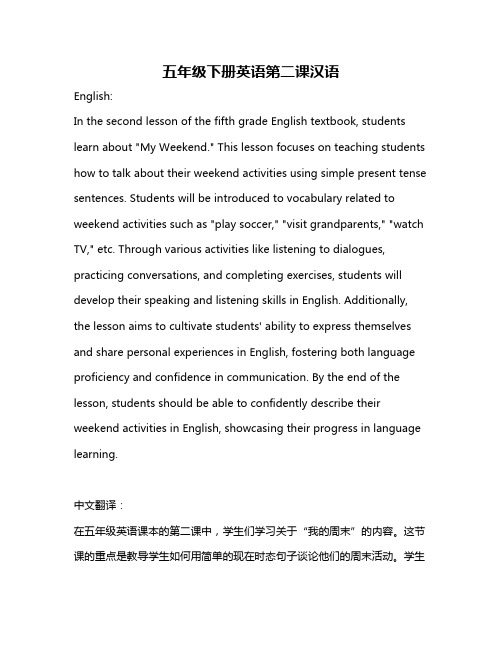
五年级下册英语第二课汉语English:In the second lesson of the fifth grade English textbook, students learn about "My Weekend." This lesson focuses on teaching students how to talk about their weekend activities using simple present tense sentences. Students will be introduced to vocabulary related to weekend activities such as "play soccer," "visit grandparents," "watch TV," etc. Through various activities like listening to dialogues, practicing conversations, and completing exercises, students will develop their speaking and listening skills in English. Additionally, the lesson aims to cultivate students' ability to express themselves and share personal experiences in English, fostering both language proficiency and confidence in communication. By the end of the lesson, students should be able to confidently describe their weekend activities in English, showcasing their progress in language learning.中文翻译:在五年级英语课本的第二课中,学生们学习关于“我的周末”的内容。
三年级下册英语书第二课
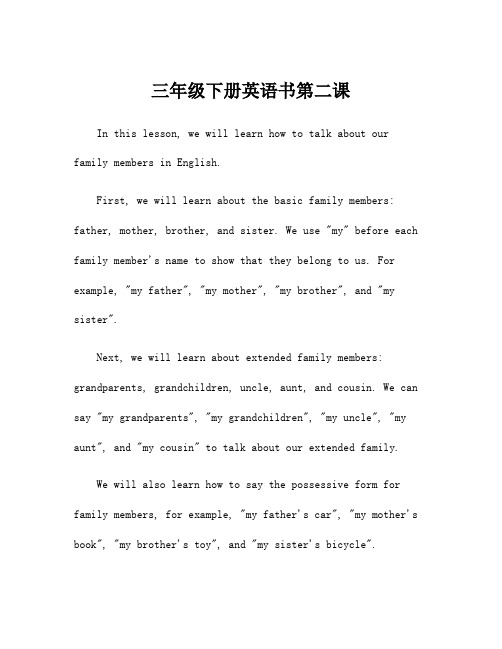
三年级下册英语书第二课In this lesson, we will learn how to talk about our family members in English.First, we will learn about the basic family members: father, mother, brother, and sister. We use "my" before each family member's name to show that they belong to us. For example, "my father", "my mother", "my brother", and "my sister".Next, we will learn about extended family members: grandparents, grandchildren, uncle, aunt, and cousin. We can say "my grandparents", "my grandchildren", "my uncle", "my aunt", and "my cousin" to talk about our extended family.We will also learn how to say the possessive form for family members, for example, "my father's car", "my mother's book", "my brother's toy", and "my sister's bicycle".In addition to learning vocabulary, we will also practice using the simple present tense to talk about our family members. For example, "My father works in an office", "My mother cooks delicious food", "My brother likes to play football", and "My sister goes to school".We will also learn how to ask and answer questions about our family members. We can ask questions like "Who is that?" and "What does he/she do?" and answer with sentences like "That's my father" and "He works as a teacher".Finally, we will learn about possessive pronouns like "his" and "her" to show that something belongs to a family member. For example, "This is his hat" and "That is her bag".By the end of this lesson, we will be able to confidently talk about our family members in English and understand how to use possessive forms and possessive pronouns correctly. Let's start practicing!。
低段小学英语口语兴趣班第二课课件.
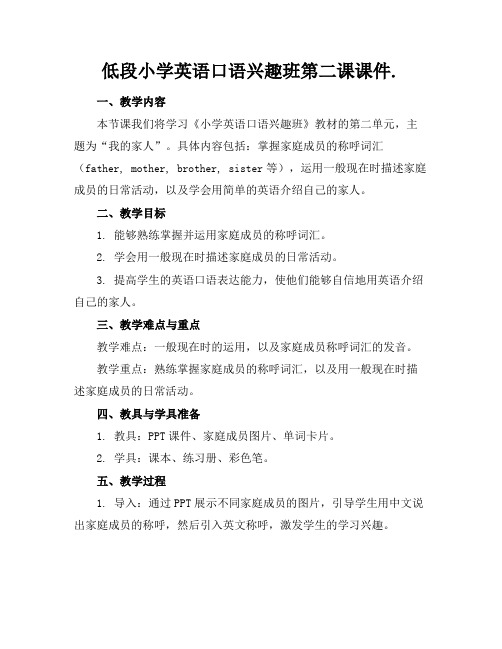
低段小学英语口语兴趣班第二课课件.一、教学内容本节课我们将学习《小学英语口语兴趣班》教材的第二单元,主题为“我的家人”。
具体内容包括:掌握家庭成员的称呼词汇(father, mother, brother, sister等),运用一般现在时描述家庭成员的日常活动,以及学会用简单的英语介绍自己的家人。
二、教学目标1. 能够熟练掌握并运用家庭成员的称呼词汇。
2. 学会用一般现在时描述家庭成员的日常活动。
3. 提高学生的英语口语表达能力,使他们能够自信地用英语介绍自己的家人。
三、教学难点与重点教学难点:一般现在时的运用,以及家庭成员称呼词汇的发音。
教学重点:熟练掌握家庭成员的称呼词汇,以及用一般现在时描述家庭成员的日常活动。
四、教具与学具准备1. 教具:PPT课件、家庭成员图片、单词卡片。
2. 学具:课本、练习册、彩色笔。
五、教学过程1. 导入:通过PPT展示不同家庭成员的图片,引导学生用中文说出家庭成员的称呼,然后引入英文称呼,激发学生的学习兴趣。
2. 新课内容:学习家庭成员的称呼词汇,以及一般现在时描述家庭成员的日常活动。
通过教师示范、学生模仿、小组互动等形式进行练习。
3. 例题讲解:讲解一般现在时的构成,以及如何用一般现在时描述家庭成员的日常活动。
结合实例进行讲解,帮助学生更好地理解和掌握。
4. 随堂练习:发放单词卡片,让学生两人一组,互相提问并回答家庭成员的称呼和日常活动,提高学生的口语表达能力。
5. 小组活动:将学生分成若干小组,让他们用所学知识介绍自己的家人,培养学生的合作精神和口语表达能力。
六、板书设计1. 家庭成员称呼词汇列表。
2. 一般现在时的构成和用法。
3. 例句展示。
七、作业设计1. 作业题目:用一般现在时描述你的家庭成员的日常活动,不少于5句话。
答案示例:My father goes to work at 8 o'clock every morning. My mother cooks delicious food for us every day. My brother plays basketball after school. My sister likes reading books in her free time. I watch TV with my family in the evening.2. 课后练习册相关练习。
三年级英语第二课
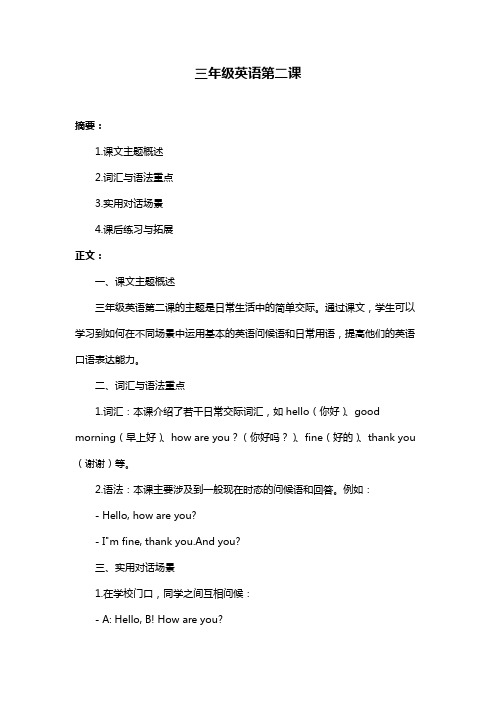
三年级英语第二课摘要:1.课文主题概述2.词汇与语法重点3.实用对话场景4.课后练习与拓展正文:一、课文主题概述三年级英语第二课的主题是日常生活中的简单交际。
通过课文,学生可以学习到如何在不同场景中运用基本的英语问候语和日常用语,提高他们的英语口语表达能力。
二、词汇与语法重点1.词汇:本课介绍了若干日常交际词汇,如hello(你好)、good morning(早上好)、how are you?(你好吗?)、fine(好的)、thank you (谢谢)等。
2.语法:本课主要涉及到一般现在时态的问候语和回答。
例如:- Hello, how are you?- I"m fine, thank you.And you?三、实用对话场景1.在学校门口,同学之间互相问候:- A: Hello, B! How are you?- B: I"m fine, thank you.And you?- A: I"m fine too.2.早晨上学时,学生与老师问候:- Student: Good morning, teacher.- Teacher: Good morning, student.How are you today?- Student: I"m fine, thank you.And you, teacher?- Teacher: I"m fine too.四、课后练习与拓展1.学生可以在家人的帮助下,运用所学词汇和语法进行角色扮演,模拟日常对话场景。
2.学生可以尝试用英语向朋友、家人问好,并互相询问对方近况。
3.教师可以设计相关课堂活动,如英语角、情景对话等,让学生在实际场景中运用所学知识。
通过本课的学习,学生可以掌握基本的英语问候语和日常用语,为今后的英语学习打下坚实基础。
英语口语入门-Lesson 2
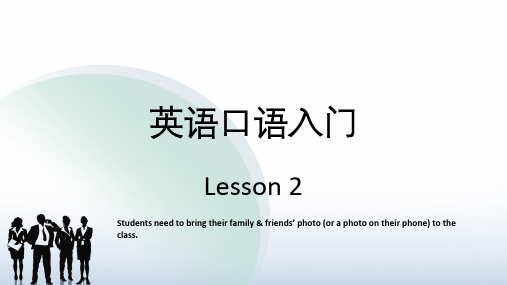
• Ask a student the following question: “Who’s he/she?” by pointing at someone in his/her picture. Next, model the following sentences:
• Who’s he/she?
• He/she is my
. (grandmother) He/she is
. (short)
Activity 3: Plural objects
• Hold one pen up and ask: What’s this?
• Hold up a second pen, point to the two pens, and ask: What are these?
• Then have students ask each other about pictures.
• What’s this/ that? It’s a/an .
• What are these/ those? They are
.
Activity 4: Daily Activities
• Vocabulary:
J:
jump
doll exit
five game hand in
juice
dog end
four go hat it
- 1、下载文档前请自行甄别文档内容的完整性,平台不提供额外的编辑、内容补充、找答案等附加服务。
- 2、"仅部分预览"的文档,不可在线预览部分如存在完整性等问题,可反馈申请退款(可完整预览的文档不适用该条件!)。
- 3、如文档侵犯您的权益,请联系客服反馈,我们会尽快为您处理(人工客服工作时间:9:00-18:30)。
»Class begin!!!
Good afternoon!
下午好!!!
Good afternoon! 下午好!!!
Good afternoon!Students!
学生们 Good afternoon! Teacher!老师
1.What’s your name?
你的名字叫什么?
2.How old are you?
你几岁了? 3.Where are you from?
你来自哪里?
4.What’s garde are you in? 你在几年级? 5.what’s class are you in? 你在几班? 6.What do you like? 你喜欢什么?
Where;
哪里;
What;
How;
什么,那个;
你喜欢什么? 我喜欢·· ·
数字单词
• • • • • • • • • • • One 1 Two 2 Three 3 Four 4 Five 5 Six 6 Seven 7 Eight 8 Nine 9 Ten 10 Zero 0
Excuse me! 对不起打扰一下。
Sorry.对不起!
How are you ?你好吗?
你好,你来自 哪里?
我来自湖南省。ຫໍສະໝຸດ I am from Hunan province ```
What grade are you in? I am garde```
你几年级? 我·· ·年级。
What class are you in? I am class```
你几班? 我·· ·班。
What do you like ? I like ```
怎么样;
Are
Your;
是
你的
Hello,what’s your name?
你好,你的名 字叫什么?
My name is ```
我的名字叫````
Hello,how old are you?
你好,你几岁 了?
我·· ·岁了。
I am ```years old.
Hello,where are you from?
I am fine.我很好。 I am not very well.我不是很好。 Fine 好的。 Well 棒的。 Very 非常。
Can I help you?我能帮助 你吗? Sure。可以,
Sit down.please.请坐下。
Stand up. Please.请起立。
